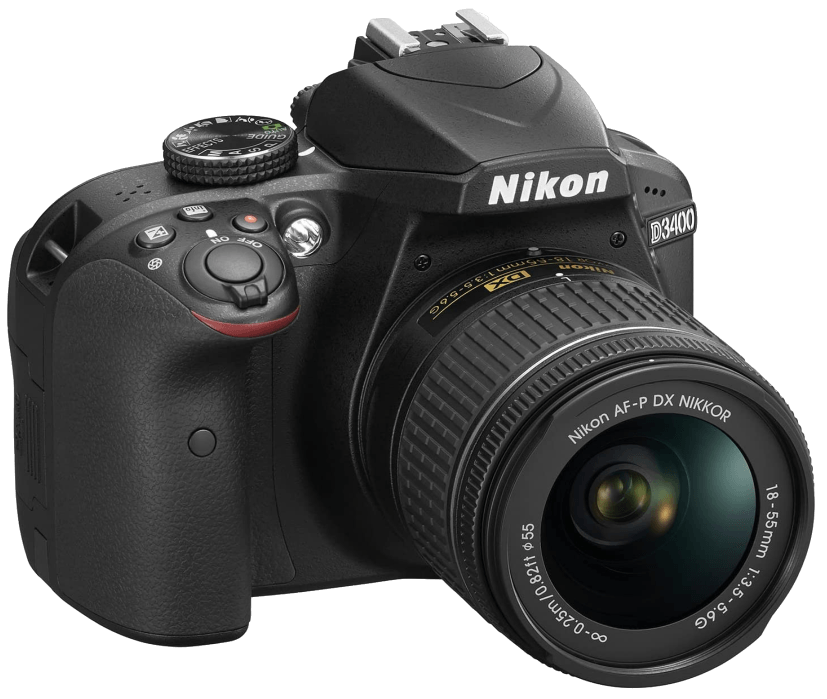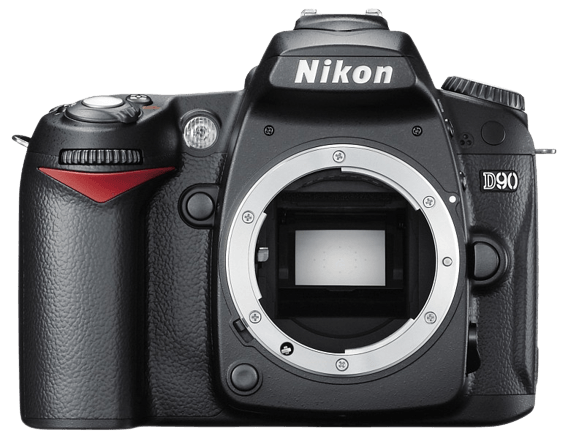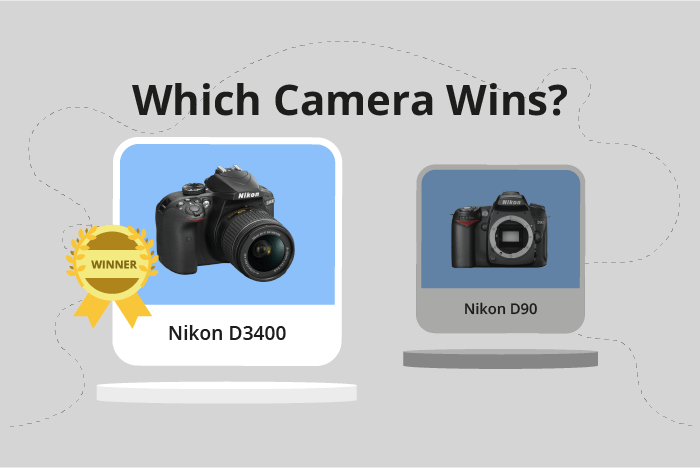Nikon D3400 vs D90 Comparison
Nikon D3400

Nikon D90

The Nikon D3400 outperforms the Nikon D90 with a score of 61/100 compared to 44/100. Both cameras are DSLR models, with the D3400 released in 2016 and the D90 in 2008. They share similar dimensions, but the D3400 is lighter at 445g compared to the D90’s 703g.
The D3400’s higher score highlights its superior performance, offering better value at a launch price of $650 compared to the D90’s $1235. The D90 has no significant advantages over the D3400, despite its higher initial cost.
The Nikon D3400 is the clear winner, providing better performance and value in a lighter package.
Nikon D3400 vs D90 Overview and Optics
The Nikon D3400 outperforms the Nikon D90 in optics, scoring 65 out of 100 compared to the D90’s 46. Both cameras share some specifications, including the CMOS sensor type, APS-C sensor size, Nikon F DX lens mount, and lack of image stabilization. However, the D3400 surpasses the D90 in several areas, making it the superior choice for optics.
The D3400 boasts a higher megapixel count at 24.2, compared to the D90’s 12.3, which results in sharper and more detailed images. Its shooting speed is also slightly faster at 5 frames per second, compared to the D90’s 4.5, allowing for better capture of fast-moving subjects. Additionally, the D3400’s Expeed 4 processor outperforms the D90’s Expeed processor, resulting in faster image processing and improved overall performance.
The D3400’s sensor also achieves a higher DXOMARK score of 86, compared to the D90’s 73, which indicates better low-light performance and a wider dynamic range. This gives the D3400 an edge in capturing images with greater detail in both highlights and shadows.
The Nikon D90 does not have any significant advantages over the D3400 in terms of optics. The only area where the D90 could potentially be considered better is its slightly lower price point, but this does not compensate for the inferior performance in optics.
The Nikon D3400’s higher megapixel count, faster shooting speed, superior processor, and better sensor performance make it the clear winner in terms of optics compared to the Nikon D90. While the D90 may be more affordable, the D3400 offers significantly better image quality and overall performance, making it the better choice for photographers who prioritize optics.
Nikon D3400 vs D90 Video Performance
When comparing the video capabilities of the Nikon D3400 and the Nikon D90, it is important to note that the Nikon D90 does not have any video functionality. Therefore, this comparison will focus solely on the video capabilities of the Nikon D3400.
The Nikon D3400 has a video score of 56 out of 100. The camera offers Full HD video resolution with maximum dimensions of 1920 x 1080. This allows users to capture high-quality footage in various settings. The camera also supports a maximum video frame rate of 60fps, providing smooth and clear motion in recorded videos. However, the Nikon D3400 does not have built-in time-lapse functionality, which may be a drawback for some users.
Considering the video capabilities of the Nikon D3400, it is clear that this camera provides a solid option for those who require video recording in their photography endeavors. On the other hand, the Nikon D90 lacks video functionality entirely, making it unsuitable for users who need this feature. The choice between these two cameras will ultimately depend on the specific video requirements of the user.
Nikon D3400 vs D90 Features and Benefits
The Nikon D3400 outperforms the Nikon D90 with a feature score of 54/100 compared to the D90’s 41/100. The two cameras share several specifications, including a 3-inch screen size, absence of touchscreen and flip screen, and lack of GPS and Wi-Fi connectivity. However, the D3400 has a slight advantage in screen resolution with 921,000 dots, compared to the D90’s 920,000 dots.
The primary advantage of the Nikon D3400 is its Bluetooth connectivity, which the D90 lacks. This feature allows for seamless image transfer between the camera and smartphones or other compatible devices, making it convenient for users to share and store their photos.
The Nikon D90 has no notable advantages over the D3400 in terms of features, as it shares most of its specifications with the D3400 and lacks Bluetooth connectivity. The lower feature score of the D90 reflects this lack of additional benefits.
In comparing the Nikon D3400 and Nikon D90, the D3400 is the superior camera in terms of features, primarily due to its Bluetooth connectivity. The D90, while sharing many specifications with the D3400, does not offer any additional benefits or advantages. Users seeking a camera with more advanced and convenient features should opt for the Nikon D3400.
Nikon D3400 vs D90 Storage and Battery
The Nikon D3400 outperforms the Nikon D90 in the storage and battery category with a score of 45/100 compared to the D90’s 37/100. Both cameras possess one memory card slot and do not support USB charging. They also share compatibility with SD and SDHC memory cards, but the D3400 has the added advantage of accepting SDXC cards, providing more storage options.
The D3400 holds a significant advantage in battery life, offering 1200 shots per charge using the EN-EL14a battery, while the D90 provides 850 shots with its EN-EL3e battery. This difference allows the D3400 user to capture more images before needing a battery replacement.
Though the D90 falls short in this comparison, it still offers a decent battery life and storage capacity. However, the D3400’s superior battery life and additional memory card compatibility make it the better choice in terms of storage and battery performance.
Nikon D3400 vs D90 – Our Verdict
Are you still undecided about which camera is right for you? Have a look at these popular comparisons that feature the Nikon D3400 or the Nikon D90:

